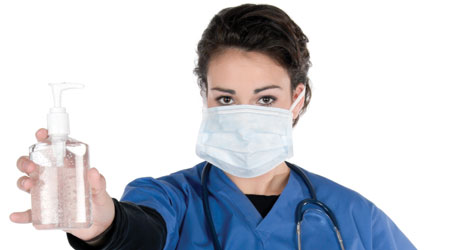
Alcohol hand sanitizers, also known as hand rubs, definitely have their place in a proper hand hygiene program, but they can also be a source of discouraging pain when applied to skin-damaged hands. Once hands are cracked, an intense program to rehydrate the skin should be a priority. Well-hydrated hands are easier to clean and provide the major defense against contact dermatitis.
Cleaning departments can help building occupants maintain healthy hands by selecting the best cleaning, easily rinsed soap, and pairing it with an effective emollient-balanced alcohol hand sanitizer. Do not base hand sanitizer selection on the mere level of alcohol, as formulation of sanitizers in an anti-HAI (hospital acquired infection) arsenal is not simply diluted ethyl alcohol.
Instead, well-formulated alcohol sanitizers have controlled-release systems, which help spread the alcohol and hold it in place for maximum effectiveness. Emollients, skin’s moisture maintainers, take over as a final protective action.
Managers are advised to base product selection on laboratory data and readily available clinical backup from a reputable supplier. Avoid suppliers that treat hand soaps and sanitizers as a sideline, line-filler or are so focused on chemistry and chemicals that they ignore the skin care factors.
Handwashing Alternatives
For staff exhibiting strong sensitivities to soap, Handwashing For Life recommends using their SaniTwice program for cleaning hands. It uses hand sanitizer as a primary cleaning agent, followed by a second application of sanitizer to kill any remaining pathogens. Effectiveness studies have been published in the Journal of Food Protection where they state this two step protocol “…was equivalent or superior to hand washing with soap and water…”
To wash with hand sanitizer, take an excess of product and scrub with plenty of friction for at least 20 seconds, removing the loosened contaminants by wiping vigorously with a single-use paper towel. That completes the cleaning step.
Hand sanitizer is then applied a second time, according to label instructions, as a kill step.
Not only is this an option for persons sensitive to soap, but it can be used anytime staff wants a bit more effectiveness than a standard hand sanitizer application and doesn’t have access to a sink. For example, this can be the case if staff:
• Doesn’t want to leave the patient’s bedside.
• Is pushing a wheelchair and doesn’t want to leave the patient’s side.
• Is responding to a patient emergency.
• Is helping out a patient in rehab.
All that’s needed is a hand-sanitizer dispenser and a box of quality paper towels.
Handwashing That Prevents Dermatitis
Products That Can Improve Hand Hygiene

 The Down and Dirty on Cleaning in Virus Season
The Down and Dirty on Cleaning in Virus Season How Surfactant Use is Expanding in Commercial Cleaning
How Surfactant Use is Expanding in Commercial Cleaning Clean Buildings Conference
Clean Buildings Conference
